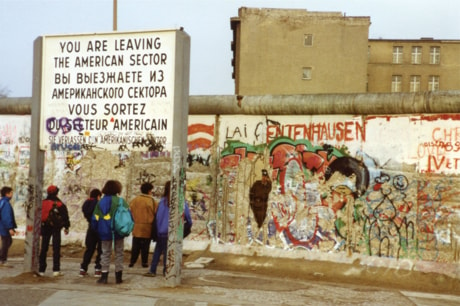When it comes to experiencing historic moments in world history, sometimes you just have to be in the right place at the right time. Twenty years ago, Rob Porkka, director of international services for Red Deer Public School District, was living in Germany and working as a teacher in a Canadian Department of National Defence school in Baden-Soellingen, West Germany.
As a resident of Germany from 1989 to 1992, Porkka had the opportunity to watch firsthand the events that led to the fall of the wall that separated East and West Germany.
He also had the chance to observe the first steps to the eventual reunification of Germany and the reestablishment of Berlin as a cultural and economic leader in Europe.
“I was so fortunate to be living in Germany when the wall came down. In the first days, people were afraid that it was only a temporary thing and many people fled from the East side with all of their possessions,” said Porkka.
“It was like watching a massing influx of refugees, but as time went on we all realized that this was not a temporary situation. People from the west took chisels and sledge hammers to the wall and began tearing it down. I went out and bought a sledge hammer and chisel. I still have a little piece of the wall.”
Recently, Porkka found himself back in Berlin attending a conference during the 20 year celebration of the fall of the wall. As he stepped from the elevator into the lobby of his hotel, he once again found himself in the right place at the right time when he stood within a few metres of George Bush Sr. and Mikhail Gorbachev.
“When I realized who they were, I just stood there for a few moments and took it all in,” said Porkka. “They were reminiscing about what Berlin was like then and what it is like now. It was absolutely fascinating to be there. I would have stayed longer if not for the secret service agents. ”
While he enjoyed seeing two former Cold War leaders up close and overhearing their discussion of the changes that have taken place in Germany since the fall of the wall, he also took a few days to explore the area and saw many positive changes that have occurred since he lived there almost two decades ago.
“I was amazed at the changes that have taken place in the city over the past 20 years,” said Porkka. “The infrastructure improvements alone are incredible, especially on the east side of the city. There has been so much construction. The Reichstag building has been renovated and restored as the parliament building and the train station is one of the finest in all of Europe. The difference between east and west Berlin is almost seamless.”
Porkka was also impressed with all that the modernized city has to offer visitors. There was an abundance of cultural and historic sites to be seen and as a former history teacher, Porkka found Berlin to be fascinating. “Modern day Berlin is much different from the Berlin I knew 20 years ago,” said Porkka. “Berlin is emerging once again as one of the most significant cultural and economic capitals in Europe.”
Fast facts about the Berlin Wall
• The 45-km long Berlin Wall stood between East and West Berlin from 1961 to 1989.
• The fall of the wall is celebrated as Nov 9, 1989, because that is the date that an inexact translation of an order, a confused border guard, and a desire for a better life led to an opening in the wall and eventually to the end of the Cold War.
• In a speech at the Brandenburg Gate commemorating the 750th anniversary of Berlin on June 12, 1987, Ronald Reagan challenged Mikhail Gorbachev, then general secretary of the Communist Party of the Soviet Union to tear down the wall as a symbol of freedom in the Eastern Bloc.
If you go:
• There are many museums and cultural events to experience in Berlin, but a good way to learn about the 800-year history of the city is to visit www.story-of-berlin.de
• To learn about the famous Checkpoint Charlie crossing point, visit the Checkpoint Charlie Museum (www.mauermuseum.de/english/frame-index-mauer.html).
• Be sure to visit the Reichstag Building, the German parliament building. During the Second World War, this parliament building was severely damaged. The building was restored after the war as a conference centre for government as the capital of West Germany was moved to Bonn. With reunification of the two Germanys in 1989, the Reichstag was renovated and once again became the parliament (www.bundestag.de/htdocs_e/visits/index.jsp).
• To learn about the other museums in Berlin, visit www.visitberlin.de/english/sightseeing/e_si_museen.php
• Food: Berlin has many choices. One interesting choice that Porkka recommends is Turkish food. Berlin has one of the largest Turkish populations in the world outside of Turkey. He particularly enjoyed HASIR Restaurant (six locations in Berlin — www.hasir.de). Cost including tax for dinner was about $40 per person.
• Transportation: Rail travel in Germany is excellent. Many passes such as Eurail or discount cards are available to travellers. The Berlin train station (hauptbahnhof) is one of the most modern stations in the world and is worth a visit even if you are not travelling by train (www.hbf-berlin.de/site/berlin__hauptbahnhof/en/start.html).
• There are direct flights from Calgary to Frankfurt with connector flights to Berlin or you can catch an Inter City Express Train from Frankfurt that takes about four hours and leaves directly from the airport train station or the Frankfurt AM Main railway station.
Debbie Olsen is a Lacombe-based freelance writer. If you have a travel story you would like to share or know someone with an interesting travel story who we might interview, please email: DOGO@telusplanet.net or write to: Debbie Olsen, c/o Red Deer Advocate, 2950 Bremner Ave., Red Deer, Alta., T4R 1M9.
